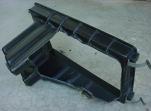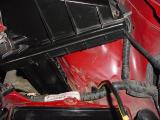

|
|
Who wants to spend money? I would if I had any. Generic cone filters can be had on eBay for cheap, but they don't provide power gains nearly significant as a full cold air intake setup. In my case, I already had a K&N replacement panel filter, so I decided to see what I could do to the stock airbox. For free.
Inspiration comes from the intake mods ("ghetto" or otherwise) done to cars at the 2001 KC Geekout. The fastest way to make some noise on a stock SR20DE car is to remove the bottom half of the airbox, and zip-tie the filter to the top part of the box. Unfortunately, my zip-ties weren't long enough, so I had to be more Innovative. The way I did it, I was able to keep the stock function of the airbox clips and keep the top of the airbox from flopping around on the intake hose. How? Using the most basic automobile engineering: cutting Speed Holes, or rather one large speed hole.
From the factory, air enters the airbox through the driver's front side, passing through a tinny-sounding plastic pipe and useless sound-deadening resonator chamber. Toss. I cut the two sides off the airbox bottom that face the car's left-front, trying to mainly draw air drawn from behind the headlight, rather than the rest of the engine bay (if possible). My cutting path also left the three stock bolt holes in place, keeping the airbox sturdy. The area cut is shown in these pictures:Right now in the basements of auto manufacturer buildings, engineers are getting paid to make cars quieter, and to mask the operations of the engine (which can be seen as a giant air pump). Bah. If you're reading this, you're not in the majority of motoring squares who only want to hear the engine to confirm that it starts. No, the motor is meant to be heard, and uncorking it is the thing to do, money willing.
 The finished piece |
 Installed |
 Another view |
 Fender resonator |
I don't imagine there is much horsepower to be made from this mod, but the sonic improvements make it the first thing to do to a stock SE-R. The intake remains quiet below 3000RPM and under low load, but get down on it, and the engine makes a nice warble in place of the stock metallic whirring. It's hard to believe the manufacturers think people would rather have silent running over that.A high-RPM Dremel tool with a cutoff disk worked very well, slicing through the plastic like, well, a hot knife through butter. I used a sheet of sandpaper to smooth the cut edges, and then wiped off the plastic dust.